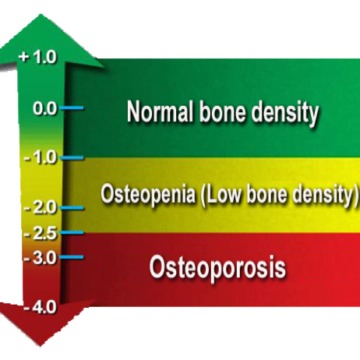What is Osteoporosis / Osteopenia?
Osteoporosis Canada defines it as a disease characterized by low bone mass and deterioration of bone tissue, which can lead to increased risk of fracture. Osteopenia is less severe than osteoporosis.

Known as “The Silent Thief”, osteoporosis leads to bone deterioration that can occur over a number of years without any symptoms. Often the first sign of osteoporosis is a fracture and by that time the disease is more advanced and less treatable.
Risk Factors for Osteoporosis
No single cause has been identified but there are many risk factors.
- Advancing age
- Fragility fracture after age 40
- Parental history of hip fracture
- Race – Caucasians and Asians have a higher risk
- Low body weight (less than 132 lbs or losing more than 10% of your body weight since age 25)
- Low estrogen in women
- Low testosterone in men
- Medical conditions that inhibit absorption of nutrients and other medical conditions associated with Osteoporosis (Rheumatoid arthritis, primary hyperparathyroidism, hypogonadism, chronic inflammatory conditions)
- Medications that can contribute to bone loss (glucocorticoids, chemotherapeutic drugs, etc.)
- High alcohol intake (greater than three drinks per day)
- High caffeine intake (greater than two per day)
- High salt intake
- Lower calcium and low vitamin D intake
- Smoking
- Inadequate physical activity
Facts about Osteoporosis / Osteopenia
- Two million Canadians are affected by osteoporosis
- Women and men both achieve peak bone mass at an early age (16-20 years in young women and 20-25 years in young men)
- Menopausal women lose bone at a greater rate (2-3% / year)
- At least 1/3 women and 1/5 men will break a bone due to osteoporosis
- The most common sites of fracture are the WRIST, the SPINE, the HIP and the SHOULDER
- Over 80% of all fractures in people over the age of 50 are caused by Osteoporosis and less than 20% receive adequate diagnosis and treatment
- Fractures from Osteoporosis are more common than heart attach, stroke, and breast cancer combined
Osteoporotic Fractures Can Lead To
- Chronic Pain
- Disfigurement (Kyphosis, etc.)
- Decreased mobility
- Fear of falling
- Loss of independence
THE ABOVE CAN LEAD TO ISOLATION, POOR SELF-ESTEEM & DEPRESSION
Ask Your Doctor About a Bone Density Test
All men and women ages 65 and older should have a bone density test. Postmenopausal women and both men and women aged 50 and older with any of the risk factors identified above should talk to their doctor about a bone density test.
Osteoporosis Management
Osteoporosis is managed with Medications, Nutrition and Exercise.
MEDICATION
- Biphsophonates such as Actonel, Fosavance, and Fosamax bind to the bone surface to slow down the rate of bone reabsorption
- Bone Metabolism Regulators such as Prolia inhibit the activity of the cells that reabsorb bone
NUTRITION
- A diet with adequate calcium and vitamin D is important as these are the building blocks for bone.
AGE CALCIUM VITAMIN D 4-8 1000 mg 600 IU 9-18 1300 mg 600 IU 19-50 1000 mg 400-1000 IU 50+ 1200 mg 800-2000 IU
EXERCISE AND PHYSICAL ACTIVITY
Exercise and physical activity are important for bone health. Impact and weight bearing activity are the most important.
Reasons to exercise include:
- To stimulate bone mass
- To strengthen the muscles which minimizes stress on the bones
- To prevent and reduce deformity
- To improve balance to minimize falls and fractures
- To recover function and decrease pain following a fracture
- To reach physical activity guidelines
Physiotherapy Can Help
A registered physiotherapist with extra training in the management of osteoporosis is an important part of the team when managing this disease. Making a commitment to a physiotherapist supervised exercise program will ensure that you are doing the right exercises in the correct way to achieve optimal results. Review our blog post about physiotherapy and osteoporosis for more information.
